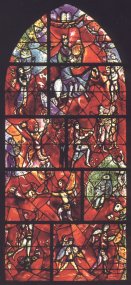
|
Creating from the heart
The Rectory, September 1998
Inspired by Peter Hoare’s article on the new British Library near St Pancras Station in London, Eileen and Jim McLean went to see the wonderful new architecture. They came back full of enthusiasm not only about the exhibitions on the history of writing, paper and books in the foyer areas but also about the display of ancient manuscripts. These include the earliest fragments of the gospels from around 100AD and the oldest complete manuscript of the New Testament dating from the fourth century. So, doubly-inspired, George and I went to see and be amazed. We were amazed and impressed by a building which is itself a work of art and the displays within it. But we were also captivated by an exhibition we went to see of the work of Marc Chagall at the Royal Academy called Love and the Stage.
Chagall
 Marc Chagall, who died in 1985 aged 97, was a Russian painter who lived most of his
life in France but never lost touch with his Russian Jewish roots. These inform and
enliven his colourful canvases which are peopled with ordinary folk: fiddle players,
lovers, actors and circus performers, goats, cows, hens and roosters! They evoke his early
years in his home town of Vitebsk near Minsk. This exhibition focuses on his work for the
Yiddish Theatre in the years just after the Bolshevik Revolution of 1917 when he was back
in Russia, and on his enduring love for his wife Bella whom he married at this time. He
paints Bella sailing to the top of the canvas holding onto his hand as he stands on the
ground where they have clearly just finished a picnic and another of them both floating
over Vitebsk. As the author of the catalogue comments:
Marc Chagall, who died in 1985 aged 97, was a Russian painter who lived most of his
life in France but never lost touch with his Russian Jewish roots. These inform and
enliven his colourful canvases which are peopled with ordinary folk: fiddle players,
lovers, actors and circus performers, goats, cows, hens and roosters! They evoke his early
years in his home town of Vitebsk near Minsk. This exhibition focuses on his work for the
Yiddish Theatre in the years just after the Bolshevik Revolution of 1917 when he was back
in Russia, and on his enduring love for his wife Bella whom he married at this time. He
paints Bella sailing to the top of the canvas holding onto his hand as he stands on the
ground where they have clearly just finished a picnic and another of them both floating
over Vitebsk. As the author of the catalogue comments:
Chagall present us in his paintings with an unfamiliar but fascinating life in which he often defies the laws of gravity, lifting his viewers into a kind of heaven-on-earth which he combines with the basest of human existence.
His delight in the earthly and the divine is transparent and it has its roots in his Jewish Hasidic background which encouraged a joy in earthly life through a sense of the divine presence. As one writer put it: God dwells where one lets Him in. But Chagall was not constrained by his background. He drew on Christian imagery and produced some of the twentieth century’s most brilliant stained glass windows where the biblical figures seem to float in light and colour. His work has without doubt a mystical quality, yet they are also full of wit and of delight in earthly things.
Three quotations from his writings reveal the importance to him of living out of a tradition, of trusting the heart not just the intellect, and of believing in love - all of which are expressed in his paintings.
Man is like a tree, his roots lie in the earth of his country. Then the branches may spread out over the whole world. Of course, there are trees that hang in mid-air and other than stand in water. But those that are rooted in solid ground bear the best fruit.
If I create from the heart, nearly everything works; if from the head, almost nothing.
Despite the troubles of our world, I have kept faith with love of the inner life in which I was raised, and man’s hope in love. In our life there is a single colour, as on an artist’s palette, which provides the meaning of life and art. It is the colour of love. Basically we are all alike. And we’re probably nostalgic, not for what we would like to know or for things outside ourselves, but for our own dreams, our own impulses towards a revolution in our inner life, which is - the discovery of purity, of simplicity, of naturalness, such as the faces of children or the voice of the one whom we have the habit of calling Divinity.
Standing within a tradition but growing out from it. Living, and praying, from the heart. Putting your hope in love and keeping faith with love. Following the impulse towards a revolution in your inner life which is towards simplicity, purity and naturalness, as in the voice of the one we keep calling Divine. For me the paintings seem to communicate this hope and encourage living in it.
Return to the Logoi contents page
http://www.stpetersnottingham.org/editorial/9809.htm
© St Peter's Church, Nottingham
Last revised 30th August 1998